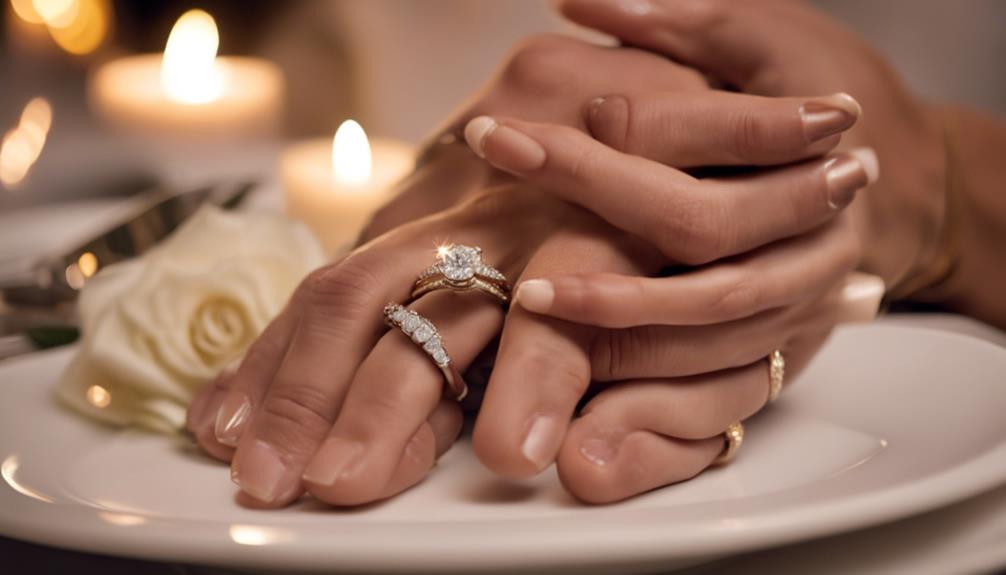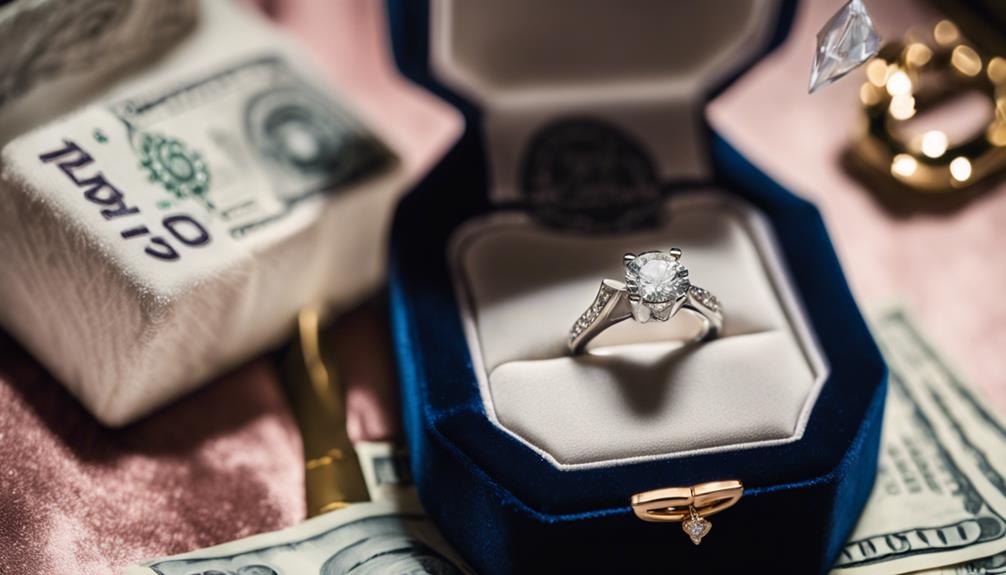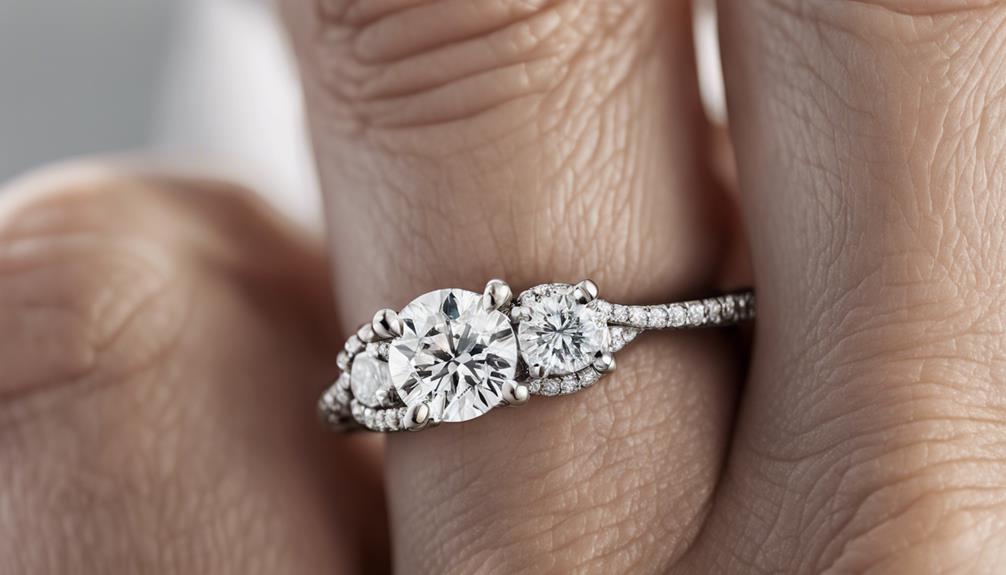An engagement ring isn’t the same as a wedding band. Engagement rings symbolize the promise of future marriage, usually featuring a prominent gemstone like a diamond. They’re worn from the proposal until the wedding. Wedding bands, on the other hand, are exchanged during the ceremony and signify a lasting union. They’re often simpler in design, crafted for everyday wear. Engagement rings are generally more expensive due to their elaborate settings, while wedding bands are more cost-effective. The tradition often places the wedding band beneath the engagement ring on the left hand. Discover more about these meaningful symbols and their roles.
Differences in Symbolism

Engagement rings and wedding bands each carry distinct symbolic meanings that reflect different stages of a couple’s journey. When you present an engagement ring, you’re expressing a promise of marriage and a commitment to a future filled with love. This ring, often adorned with a striking center stone, is a personal gift symbolizing your intent to unite your life with your partner’s. It’s a declaration of love and a significant step in your relationship.
On the other hand, wedding bands are exchanged during the wedding ceremony, embodying the union and ongoing commitment you and your partner share. These rings, usually crafted from precious metals like gold or platinum, represent eternal love and the continuity of marriage. Unlike the engagement ring, a wedding band isn’t just a gift from one partner to another but a mutual exchange that underscores the shared commitment between you both.
Understanding the symbolism behind these rings is essential as it highlights different facets of your relationship. While the engagement ring marks the beginning of your journey, the wedding band signifies the enduring love and partnership you both vow to maintain throughout your lives together.
Design and Material Variations
When exploring the design and material variations between engagement rings and wedding bands, you’ll notice distinct differences that align with their unique purposes.
Engagement rings often showcase a prominent center stone, typically a diamond, surrounded by smaller stones, creating an intricate and eye-catching design. This design is meant to symbolize the promise of marriage and the initial commitment.
In contrast, wedding bands focus on minimalism, often crafted from plain metal or subtly adorned with small diamonds, emphasizing durability and the ongoing commitment shared between partners.
You’ll find that the materials used also differ. Engagement rings offer a wide range of customization options, allowing for elaborate settings and unique shapes tailored to personal preferences. This customization can include choosing specific gemstones, metals, and intricate designs.
On the other hand, wedding bands are generally simpler, with designs that might include matching sets or straightforward metal bands that complement the engagement ring without overshadowing it.
Ultimately, these design and material variations reflect the distinct roles these rings play in a couple’s journey, from the promise of a future together to the enduring partnership celebrated during the wedding ceremony.
Cost Comparison

The price tag often sets engagement rings apart from wedding bands, largely due to their intricate designs and the inclusion of a prominent center stone, usually a diamond. Engagement rings are typically more expensive because they often feature elaborate settings and a considerable gemstone, which drives up the cost. On average, you might find that an engagement ring costs about three to five times more than a wedding band.
Wedding bands, on the other hand, tend to have simpler designs. They’re often crafted from precious metals and may include minimal gemstone embellishments, if any at all. This simplicity considerably reduces their cost, usually making them about 10% of the price of engagement rings. The price difference is quite stark, reflecting the emphasis on the main gemstone in engagement rings compared to the understated elegance of wedding bands.
When considering your budget, you might notice some couples are now choosing to allocate a single budget for both rings. This strategy allows them to invest in one standout piece instead of purchasing two separate rings.
This approach can make financial sense, especially if you’re looking for a balance between style and cost.
Ring Finger Traditions
Wearing rings on specific fingers holds deep symbolic meaning in many cultures. When it comes to engagement rings and wedding bands, tradition often points to the fourth finger of your left hand, known as the ring finger. This is because it was once believed to have a vein running directly to your heart, making it a powerful symbol of love and commitment.
As you navigate these traditions, you might find yourself considering the following:
- Traditionally, you wear the engagement ring on your left hand’s ring finger until the wedding.
- During the ceremony, the wedding band is placed on the ring finger, often beneath the engagement ring.
- Some couples choose to move the engagement ring to the right hand after the ceremony, allowing the wedding band to be the primary focus on the left hand.
- Ultimately, how you wear your rings often comes down to personal preference, with comfort and style influencing your decision.
While these traditions provide a beautiful framework for expressing love, there’s flexibility.
Whether you opt for stacking rings, wearing them together, or choosing separate fingers, the key is finding what feels right for you as a couple.
Choosing the Right Rings

As you contemplate traditions around ring placement, selecting the right rings becomes an exciting journey that reflects your unique love story.
Understanding the engagement ring vs. wedding ring distinction is essential. An engagement ring, typically presented during the proposal, often features a prominent center stone, like a diamond, symbolizing the promise of marriage. In contrast, the wedding band is exchanged during the ceremony, signifying your union and ongoing commitment.
When you choose a wedding band, think about how it complements your engagement ring. Consider design compatibility and comfort, especially if you plan to wear both rings together.
Engagement rings and wedding bands can either match or contrast, depending on your personal preferences. Some couples prefer a matching wedding band set for a cohesive look, while others choose distinct styles to reflect their individual tastes.
Conclusion
In your journey of love, understanding the differences between an engagement ring and a wedding band is key. Engagement rings announce your intention to marry, often with a dazzling gemstone, while wedding bands symbolize your vows and enduring love. They vary in design, materials, and cost, and traditions guide which finger they adorn. By embracing these distinctions, you’ll confidently choose the perfect symbols for each milestone, beautifully reflecting your unique love story.



